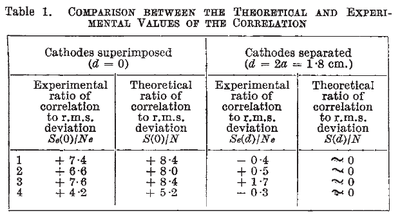
This page is among our 'okay articles'. It should be further expanded but we hope that it will still be useful in its present stage.

This paper[1] brings to the optical spectrum of visible lights (photons) the Hanbury Brown-Twiss effect of positive correlations in the intensities.
It has been very much debated in a series of follow-up papers, entitled The Question of Correlation between Photons in Coherent Light Rays.
One non-trivial question resolved by the experiment is whether the "correlations" would be preserved in the conversion from photons to the electric signal, as indeed the experiment was successful thanks to the resilience of the effect to what is, essentially, a classical (macroscopic) signal. At the time of this experiment, it was not possible to evidence the effect at the single-photon level, which was not the starting hypothesis of Hanbury anyway, although it turned out to be correct (and seed the field of quantum optics).
The light was split in two by a beam-splitter and directed on two photo-cathodes , of which was one translated sidewise and the following correlations were noted (four points for each of two distances!):
